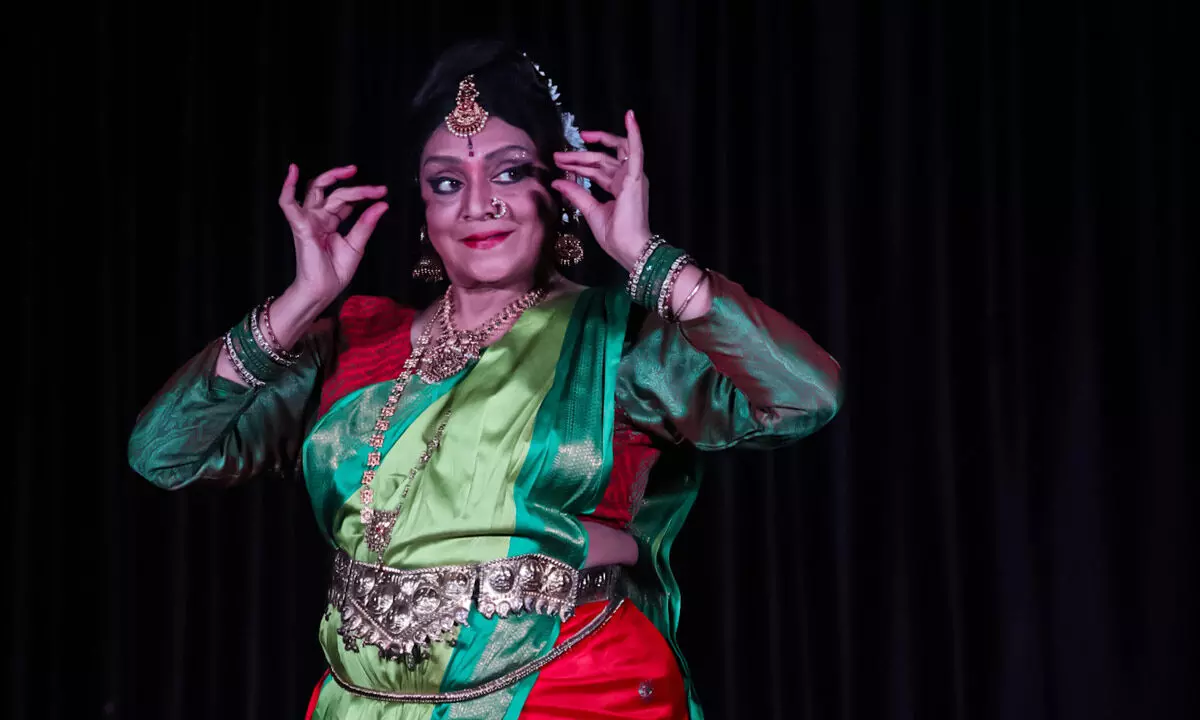“NijamugaChoochithivaNeevu, Daaninta, Cheliya...
” Swapnasundari’s expressive face and especially her eyes speak volumes as she dances to this Javali in Khamas ragam, composed by Harikamaya Kavi in dedication to Lord Janardhana of Penukonda town in Andhra Pradesh. The celebrated Kuchipudi, Bharatanatyam and Vilasini Natyam (which she revived) artiste, Swapnasundari, a Padma Bhushan awardee with a string of other awards and honours to her credit, is teaching the nuances of abhinaya via this composition to a group of dance students and teachers. This is part of a three-day workshop called Chaitra Chandrika on abhinaya, organised by Navya Nataka Samithi (NNS), Hyderabad at Sri Krishnadevaraya Andhra Bhasha Nilayam.

Swapnasundari has had a stellar career as a classical dancer and trained under masters of classical dance and Carnatic music like the venerable Mukta and stalwart M. Balamuralikrishna for instance, and is also a highly respected scholar and author known for her passion for research and deep knowledge of art-related subjects. All this has also made her an acclaimed choreographer.
Swapnasundari, singing the composition herself, demonstrates the various ways to express the mood of this song. Herein, Lord Krishna’s partner, stricken with suspicion and jealousy, asks her female companion: “Did you really see him (Krishna) go to the house of the ‘other woman’? And that too so brazenly, without any attempt to be discreet..
.in broad daylight?” For the unversed, Javalis are a genre of relatively ‘light’ compositions in south-Indian music in which Shringara is the main rasa and the language is more colloquial than that of Krithis. Javalis are not only an integral part of the repertoire of Carnatic music and generally sung towards the end of the concert, but also classical-dance forms like Bharatanatyam and Kuchipudi.
The third and last day was devoted to the students demonstrating the dance they had learnt, in small groups. This was followed by a Q and A session as happens towards the end of workshops. Swapnasundarai emphasised the importance of sahitya dharma, i.
e. knowing and understanding the words or lyric before composing the abhinaya in its four forms for it. She spoke of pada-ardham (word to word meaning), Vakyaardham (meaning of the whole line) and Viseshaardham (which depends on the dancer’s creativity or interpretation).
She added that Manodharma is welcome as long as it based on a total understanding of the poet/Vaggeyakara’s every word and its overt and implied meaning, emotion, mood, metaphors used, etc. She also stressed, that a dancer needs to be her/his own critic and judge as to when and whether her/his own expressions are overdone or too subtle and obscure as to be missed. One must find the perfect balance, she reiterated, giving examples for this and answers to other questions from her own journey as a dancer, her learning from masters, own experiments and how her art evolved over the years.
Most attendees expressed the desire for another such workshop very soon. Students like Maitreyi Shriraag and Madhavi and dance-teacher Vani Ramana said they “found this workshop very insightful and valuable given that abhinaya is such a core component of our classical-dance”. Explained SudhamalaNishtala, a Kuchipudi dance-teacher and doctoral student of the subject who is the NNS Coordinator: “We organised this workshop as part of our regular efforts to host programmes which preserve, promote and foster the classical art forms of music and dance from around India, and to encourage amateur talent in these arts, particularly among the youth.
” NNS or Navya Nataka samiti was established in 1958 as the drama-related wing of Navya Sahiti Samiti (established in 1952) by its founder-president Vemaraju Narsimha Rao, a noted novelist and story writer with the intention to serve Indian literature and culture. Over the decades, NNS has produced many innovative plays, playlets, musical dance-dramas and ballets, and organised music and dance workshops and seminars, etc. Add Sudhamala and Vemaraju Vijaykumar, President, NNS: “Our NNS, has carved a niche for itself in the cultural history of the twin cities.
” Two days later, as the concluding part of the event, NNS organised a dance performance titled Lasya Lathika, by Swapnasundari. However, unlike the punctual workshops, the commencement of this programme was delayed by over an hour. The programme was based on a series of Telugu compositions by Vaggeyakaras of the four southern states.
Swapnasundari captivated the audience with her exquisite abhinaya and highly creative choreography. She also sang snippets of the songs and the dances were interspersed with nuggets of information given by her about the compositions and their style of rendition. She started off with the customary Pushpanjali in Anandabhairavi ragam, and it was performed in the Agama Narthana Paddhati of the Sri Subramanya temple in Thirutthani, Tamil Nadu.
This was followed by her dance to a composition by the Tanjore Maharaja Shahaji dedicated to the goddess Meenakshi in Gowlipanthu ragam. The highlight was the KshetrayyapadamVadharakaPove in Kambhoji ragam beginning with the Anupallavi AdiyokaYugamu, which received a detailed exposition. This is one of the more famous compositions of VaggeyakaraKshetrayya, celebrated as King of Padams, and has an interesting and well-known story behind it, which is too long to be elaborated here, however.
Swapnasundari, who performed this item mostly seated, was in her element beginning the Padam as a despondent Vipralabdha nayika and ending with the VairaagyaBhaavam. The Padam was enchanting and it showcased perfectly her sensuous grace and richly expressive abhinaya. This was followed by the popular Javali composed by an unknown poet for a Rajanarthaki in the court of the Mysore Wodeyar kings, which goes PanchabaanuduNaapaiVedalinaadu with several Sancharis at SarigaaduMounamuSarasaaksha.
After this, the audience was treated to Swathi Thirunal’s Javali in Behag ragam, namely SaaramainaMaatalenthoChaaluChaalu Ra. The programme finale wasVallabhacharya’sMadhurashtakam, a poem in praise of Lord Krishna. The dance programme received competent accompaniment from vocalist Sudha Rani of Vijayawada, violinist Sai Kolanka, mridangam artist Sridharacharya and nattuvangam by NCH Raghunandan.
.
Entertainment

THE NUANCES OF ABHINAYA

Renowned classical dancer Swapnasundari was in town for a workshop on abhinaya and a dance performance which won much appreciation for its rich grace and expressiveness















